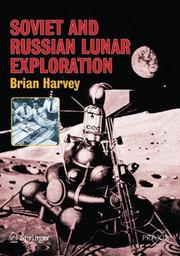| Listing 1 - 1 of 1 |
Sort by
|

ISBN: 1281043060 9786611043063 0387739769 0387218963 Year: 2007 Publisher: New York, NY : Springer New York : Imprint: Praxis,
Abstract | Keywords | Export | Availability | Bookmark
 Loading...
Loading...Choose an application
- Reference Manager
- EndNote
- RefWorks (Direct export to RefWorks)
Little is known of Soviet and Russian lunar exploration although, in fact, the Soviet Union/Russia: Sent the first spaceships past the moon, the first to hit the moon and the first to circle the moon Was first to soft land on and orbit the moon Was first to send a spaceship around the moon and recover it on Earth Came very close to sending a cosmonaut around the moon first Built and successfully tested, in Earth orbit, a lunar lander Pioneered sophisticated, precise high-speed reentries into the Earth's atmosphere Came close to perfecting a giant moon rocket, the N-1 Retrieved three sets of rock samples from the moon by automatic spacecraft Landed advanced roving laboratories that explored the moon for months on end, traveling 48km Designed long-term lunar bases. These were remarkable achievements requiring a considerable level of engineering sophistication and have a place in the contemporary story of astronautics. Recent landings on Mars use, essentially, the very techniques developed by Russia to land on and explore the moon in the 1960s and 1970s. As an acknowledged expert and author of several books on the Soviet and Russian space programme, Brian Harvey is ideally suited to cover not only the engineering and scientific side but also the human stories of the Soviet and Russian lunar programme. These include those of the cosmonaut squad that trained to land on the moon, but was stood down, and of the designers who tried to realise the dream of a Russian moon, from Tikhonravov to Mishin: a Soviet lunar programme was first proposed by designer Mikhail Tikhonravov in a children’s magazine in 1951 and he persuaded a sceptical Soviet leadership of the value of a moon programme. Following Sputnik, the first lunar flights quickly achieved the key goals of hitting, circling and photographing the moon in 1959. The Soviet Union achieved all the early ‘firsts’ in lunar exploration, such as soft landing and orbiting the moon, and Brian Harvey will recount the frantic efforts to rival America’s Apollo and the dramatic hours of 21st July 1969, when Russia tried to soft land Luna 15 in the Sea of Crises even as Armstrong and Aldrin explored the moon in the nearby Sea of Tranquility.
Astronautics. --- Space sciences --- Aeronautics --- Astrodynamics --- Space flight --- Space vehicles --- Moon --- Exploration. --- Astronomy. --- Popular Science in Astronomy. --- Aerospace Technology and Astronautics. --- Astronomy, Observations and Techniques. --- Aerospace engineering. --- Observations, Astronomical. --- Astronomy—Observations. --- Astronomical observations --- Observations, Astronomical --- Aeronautical engineering --- Astronautics --- Engineering --- Exploration --- History. --- Earth (Planet) --- Satellite
| Listing 1 - 1 of 1 |
Sort by
|

 Search
Search Feedback
Feedback About
About Help
Help News
News